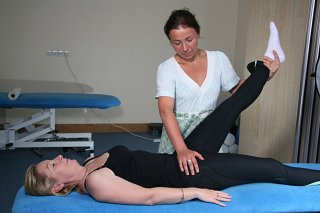Treatment for Sciatica
Treating Sciatica

When considering treatment for sciatica, it is worth noting that sciatica is commonly aggravated by activity or exercises that either flex or extend your muscles. So simply treating sciatica through exercise may not necessarily be the right thing to do. You need to discover what is causing your Sciatica before you start on a treatment program. Seek professional assistance if unsure.
Once accurately diagnosed, the structure that is traumatising the nerve must be treated resulting in pressure being removed from the sciatic nerve.
After the structural component that is compromising the nerve is resolved - your responsibility is to either avoid the positions that may cause further structural dysfunction or resolve the swelling on the nerve associated with its previous compression.
Your Physical Therapist will make this clear to you following their assessment of your sciatica symptoms.
Treatment options for Sciatica
The treatments I carry out in my own clinic on sciatica are non-aggressive and involve positioning and gently mobilising the body part that is compressing the nerve. This corrects the faulty position and mechanics of the movement causing the pain.
Following this, home exercises to further decompress the nerve are advised and resolution of pain is usually within 2-6 days. This may be combined with massage for sciatica from an experienced and well-trained massage therapist. This, however, is when the compressing structure is mobile, for example a prolapsed disc or facet joint.
If the condition is degenerative, for example osteoarthritis, then the period of time it takes to resolve the symptoms can be longer. Early stability exercises for your specific situation are of great importance.
I use the Pilates exercises with my own clients for this purpose - but have to proceed carefully as when used in the incorrect direction can cause further pain. Again expert advice is advised.
Sciatica home treatment involves ice treatment every two hours for the first 72 hours followed by heat treatment at the same intervals until symptoms have fully resolved.
Also, avoid staying in a set position for too long. Do not sit, or stand, for any longer than twenty minutes at the early stages and if sitting - then sit on a hard supportive chair with good postural alignment. When lying down, place two average pillows under your knees if lying on your back - or between your knees if lying on your side.
Depending on the severity of your symptoms you may require medication. Non steroidal anti-inflammatory drugs as well as pain killers and muscle relaxants may be indicated under the guidance of your doctor. However, long term use of such medication for sciatica is not of significant value in my opinion - you need to get at the underlying causes.
Sponsored links
DISCLAIMER
While the content and materials contained in the articles on this website have been written & researched by Sally Ann Quirke, a professional, practising & fully qualified Chartered Physiotherapist (Physical Therapist) based in Ireland, they are provided for general information and educational purposes only. They do not constitute medical advice on any particular individual situation. Please see your Chartered Physiotherapist or other medical practitioner for full and individual consultation.
Please read the full disclaimer here.
Cookies and Privacy
By using this website, you consent to the use of cookies in accordance with our cookie policy. For more information on how we use cookies, please read our cookie policy here.
